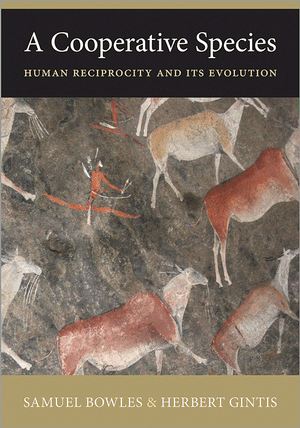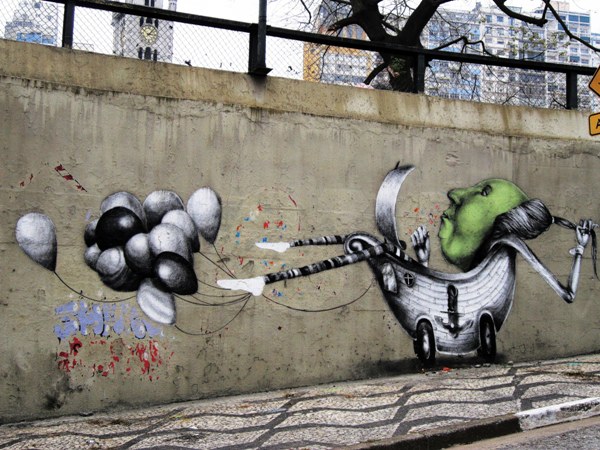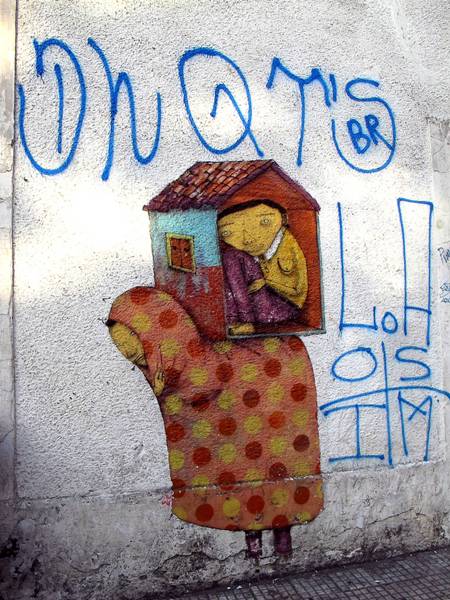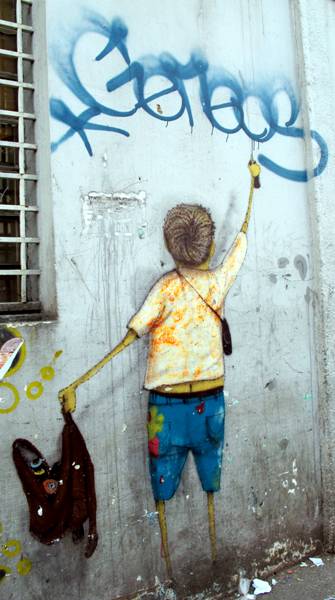 |
| gpoyw - (gratuitous picture of yourself wednesday; a tumblr tradition.) |
2011年7月27日星期三
REBELLION AGAINST PLURALISM
If we are to make sense of the horrific terror attack that shook Norway this past Friday, we must try to place it in the context of recent European politics. That context, in turn, points to one fact more than any other: over the last decade, Europeans have grown increasingly obsessed with the threat supposedly posed by foreigners, immigrants, and Muslims.
All over the continent, far-right parties have been celebrating remarkable successes. Establishment politicians, once keen to display their enlightened attitudes towards outsiders, have honed their populist rhetoric against foreigners. Books about the doom that would ensue if ethnic Europeans should become minorities in their own countries—like Germany Does Away with Itself, Thilo Sarrazin’s runaway success last year—have topped bestseller lists week in and week out.
Naturally, some commentators have expressed concern about these developments. But both in newsrooms and on the streets they mostly have been decried as fools whose obsession with multiculturalism is a naïve remnant of a more innocent era. Nothing wrong with their good intentions, Europeans of all nationalities and social strata intone, but they are sadly inapplicable to the 21st century, when islamofascism in general, and hordes of unwashed Muslims in particular, are threatening the European way of life.
Anders Behring Breivik, who has admitted responsibility for the death of seventy six innocents, is undoubtedly a madman. But madmen can be spurred on by anything in their environment they are able to construe as legitimation or encouragement—and, in recent years, there was plenty of that to go around in Europe.
HAPPY ANIMALS: THE JOY BEYOND THE STRUGGLE TO SURVIVE
From Guardian:
Six-barred angelfish
"One of nature's many mutualisms is demonstrated by cleaner fishes which pluck parasites and nibble algae and loose skin from client fishes. These relationships, built on trust and cemented by the rewards of touch and nourishment, have been well studied, but I've yet to see any specific mention of the word pleasure in any of the papers I've read. Here a team of two cleaner wrasses provide spa treatment to an angelfish. It's clearly in the angelfish's interests to get rid of parasites, but there's mounting evidence for a more immediate, complementary benefit for this behaviour: the tactile ministrations of the cleaner wrasses feel good"
"One of nature's many mutualisms is demonstrated by cleaner fishes which pluck parasites and nibble algae and loose skin from client fishes. These relationships, built on trust and cemented by the rewards of touch and nourishment, have been well studied, but I've yet to see any specific mention of the word pleasure in any of the papers I've read. Here a team of two cleaner wrasses provide spa treatment to an angelfish. It's clearly in the angelfish's interests to get rid of parasites, but there's mounting evidence for a more immediate, complementary benefit for this behaviour: the tactile ministrations of the cleaner wrasses feel good"
More here.
EVOLUTION RIGHT UNDER OUR NOSES
Carl Zimmer in The New York Times:
White-footed mice, stranded on isolated urban islands, are evolving to adapt to urban stress. Fish in the Hudson have evolved to cope with poisons in the water. Native ants find refuge in the median strips on Broadway. And more familiar urban organisms, like bedbugs, rats and bacteria, also mutate and change in response to the pressures of the metropolis. In short, the process of evolution is responding to New York and other cities the way it has responded to countless environmental changes over the past few billion years. Life adapts. The mice are the object of Dr. Munshi-South’s attention. Since 2008, he and his colleagues have fanned out across the city to study how the rise of New York influenced the evolution of the deer mice.
More here.
MINDFULNESS MEDITATION: A PRIMER AND SOME THOUGHTS
by Rishidev Chaudhuri
The general principle in Vipassana is to train one’s attention through focus on a particular object and, once this is well-trained, to use it to observe the unfolding of experience. It’s effectively a systematic way of noticing experience. The breath is typically the chosen focus. As far as I can tell, this choice is semi-arbitrary but has a number of advantages. Apart from the comforting stamp of tradition, the breath is both ever-present but also changes with emotional and mental state, giving a good starting ground both for training concentration and for training mindfulness of the multiple aspects of one’s state.
So here's a sketch of how you might start off:
Sit down (on a chair, on the floor, cross-legged or not, it doesn't matter) and bring your attention to the edge of your nostrils, where your breath enters and leaves. Again, all you want is an anchor point that you can use to train your concentration and to return to when your mind starts to get swamped by thoughts. Other foci would work.
NETWORKS, CROWDS, AND MARKETS: REASONING ABOUT A HIGHLY CONNECTED WORLD
Cosma Shalizi reviews the new book at American Scientist:
Studies dealing with what we now recognize to be social networks go back to the years around 1900, when political economists, social reformers and muckraking journalists began looking at interlocking directorates of corporate boards and other institutions through which the ruling classes (as they were then called) coordinated their actions without actually having an executive committee. People spoke of “social circles.” By the 1950s, sociologists had a notion of social networks, a concept that had a small band of enthusiastic devotees but was an esoteric idea even within mathematical social science. Even 25 years ago, the idea of networks as a form of social organization was reasonably avant-garde. (One can trace some of this evolution in Linton C. Freeman’s 2004 book, The Development of Social Network Analysis, but a proper history of the “network” concept has not yet been written.)
Nowadays, companies whose sole and explicit purpose is the formalization of social networks have hundreds of millions of active customers. (Although they are not often seen this way, these firms are massive exercises in centrally planned social engineering, inspired by sociological theories.)
More here.
THE GIRL FROM F&B: A PORTRAIT OF THE NEW INDIA
An excerpt from Siddhartha Deb's The Beautiful and the Damned: A Portrait of the New India, in The Nation:
Esther once worked as a waitress at Hotel Shangri-La, serving breakfast, high tea and happy hour drinks at the Horizon Club on the nineteenth floor. Some of her guests were businessmen passing through Delhi, while others maintained small but expensive office suites along the corridors twisting away from the club lounge. In the evening, these men sat in the lounge sipping Black Label Scotch with lots of ice, appreciative of the quiet, smiling demeanor with which Esther brought them their food and drinks, leaving them to talk to one another or on their BlackBerrys while outside the sheer glass windows the sun went down softly over the Parliament building and the palatial bungalows of industrialists and politicians. One of the men who sat in the club lounge was an arms dealer. I met him before I met Esther, although the reason I went to see the arms dealer was because I was looking for Esther.
All through the past few years in India, sometimes in Delhi and sometimes in other cities, I had noticed the women who worked as waitresses in cafes and restaurants and as sales assistants in retail stores. They were usually in their 20s, soft-spoken and fluent in English. In the shape of their eyes, their cheekbones and their light skin, I could read their origins in northeastern India. They were polite but slightly reticent until I spoke to them and told them that I too had grown up in the northeast. Then they seemed to open up, and often there were extra touches of attention as they served me. I flattered myself that they liked me. After all, I knew where they were from, I was generous with my tips and I thought I understood something of their loneliness in the loneliness I had felt when I began to leave my small-town origins behind and started my drift through cities. But in most ways, I wasn’t like them. I had grown up in Shillong, the most cosmopolitan of urban centers in the northeast, while the women were from Nagaland or Manipur, the first generation from these states to abandon their poor, violence-ridden homes for the globalized metropolises of the mainland. Their journey was longer and harder than mine had ever been, and although there were tens of thousands of them in Delhi alone, they were in some sense utterly isolated, always visible in the malls and restaurants but always opaque to their wealthy customers.
ADAPTING EVOLUTIONARY PSYCHOLOGY
John Hawks in his blog:
Bolhuis and colleagues focus on four assumptions that underlie some of the hypotheses promoted by researchers like Buss, Tooby and Cosmides:
1. Humans were once well adapted to their environment (the "environment of evolutionary adaptedness"), but recent changes to human existence have created a mismatch of some human traits with the current environment.
2. Human cognitive traits evolve slowly and gradually, so that they cannot be well adapted to recent environmental changes.
3. Human cognition occurs as an outcome of many specialized "modules" in the brain, not a few coordinated and flexible learning mechanisms.
4. Humans have the same cognitive processes whoever they are and wherever they live -- in other words, mental adaptations are universal in humans.
Knowing all of these researchers, I don't think they would agree with all of this characterization. Some aspects are uncontroversial: Many humans display behaviors that appear poorly suited to current environments but may plausibly have been an advantage in past environments. Others are more reasonable than Bolhuis and colleagues present -- for example I know that evolutionary psychologists usually express the "gradualism" assumption in a limited way, assuming that some cognitive adaptations are complex and therefore not likely to have arisen quickly as a result of a simple change in gene frequencies. Likewise, they do not assume that all human psychological traits are universal, but instead that those traits that appear universal are likely to have arisen in ancient environments shared by the ancestors of all humans. In short, I think the paper fails to accurately present the arguments put forward by mainstream evolutionary psychologists.
I've written on evolutionary psychology at some length, often in a very critical way (for a good example, check out this post about David Buller's critical work and evolutionary psychologists' lame response). But the idea of niche construction irritates me a lot more than evolutionary psychology ever does.
More here.
2011年7月26日星期二
大脑缩小是进化和长寿的代价
人类有一颗硕大的脑袋,它的功能异常的强大,能做梦,还能为复杂问题提出新解决方案。然而我们的大脑无法一直运作正常。当我们的年龄越来越大时,大脑会收缩,认知功能会下降,出现诸如失忆或痴呆等症状。一项新的磁共振成像研究发现,黑猩猩的大脑不会随时间而缩小,人类大脑缩小可能是进化和长寿的代价。乔治华盛顿大学的进化神经解剖学家Chet Sherwood领导的团队,比较了猩猩和人类的大脑收缩模式。人类和黑猩猩是在大约500万到700万年前从进化树上分离。研究样本包括87位年龄在22岁到88岁的人类,99只年龄在10岁到51岁的黑猩猩——由于野外黑猩猩很少能活到45岁,样本代表了两个物种的正常生命周期。研究人员用MRI扫描器测试黑猩猩和人类的大脑区域,发现:黑猩猩没有出现明显的与年龄有关的大脑区域收缩情况,而所有的人类大脑区域都出现了显著的年龄收缩效应。人类80岁时与20岁时相比,部分大脑区域缩小了25%,额叶灰质平均缩小了14%,海马灰质平均缩小了13%,额叶白质缩小了24%。研究发现人类70岁到80岁之间的大脑变化最显著;例如额叶白质在70岁时只缩小6%,到80岁时却达到了24%。报告发表在PNAS上。
妈妈模仿女儿,但女儿不愿模仿妈妈
妈妈注意了,你们的女儿不想穿得像你一样。根据《消费者行为学》期刊即将刊登的报告,研究人员调查了343对母女,平均年龄分别为44岁和16岁。结果显示,母亲在穿着上刻意模仿她们女儿的风格,研究人员称之为“消费者的分身效应”。研究人员询问了她们心里认为的年龄,时尚品味,服装和化妆品的知识,以及她们的母亲或女儿在多大程度上影响了她们的时尚品味。结果显示,如果一位母亲认为女儿是流行时尚专家,并认为自己还年轻,那么她有25%的可能性会模仿女儿的风格。相比之下,即使女儿认为自己心理年龄高于实际年龄,并且认为母亲很会打扮,她们也只有9%的可能性模仿母亲的风格。这项研究显示,孩子对父母消费行为的影响比以前认为的大得多。
2011年7月25日星期一
费米Tevatron加速器也观察到类似希格斯玻色子信号
在法国Grenoble举行的高能物理学欧洲会议上,LHC的ATLAS和CMS探测器研究人员宣布在130到150 GeV范围内观察到了异常信号,推测有可能是来自希格斯玻色子(上帝粒子)。BBC报导称,费米实验室Tevatron加速器的DZero和CDF探测器也在同一能量范围内(140 GeV)观察到了类似信号。物理学家正谨慎分析这些微弱的信号。DZero探测器团队发言人Stefan Soldner-Rembold教授称,在140 GeV附近存在着某些引人入胜的东西。
总统的职责
向来自以为对新加坡总统的角色很清楚。
当初,我国总统的职责,基本上是一般囯家元首通常执行的礼仪职能。在1991年,我国修改宪法,为总统增添了一些重要的监护职责。例如,保护国家储备金;有权否决公共部门职位任命;可审查政府行使内部安全法令和宗教和谐法令所赋予的权力以及调查贪污案件等。为了赋予他这些牵制政府的具体权力,总统改由全民直接选出。
以往三届总统,在执行这些宪法规定的职能时,似乎并无太大的争议。
不过,近来却听到一些声音。认为总统既由全民选出,所以也具备全民代言人的资格与任务,可以对各种政治议题,发挥其政治能量与影响力。
何光平先生在《总统的软实力》(海峡时报,7月7日)文中说,民选总统既为全民选出,有合法性,因此有替民众发声的使命。
Wan Wei Yee教授却认为,总统的权力来自宪法。而总统在公共场合对日常政治议题发言,不在宪法规定之内。这样做有违国家元首的超然地位。(《不要政治化总统的角色》,海峡时报,7月21日)
但是何先生说,总统是否能在公共场合对日常政治议题发言,属宪法的灰色地带,没有明文规定。总统在这方面将会有多少空间,是个未知数,端视个别总统与国会博弈的结果,有待衍变发展。
Wan教授则指出,宪法已有明确规定内阁与总统关系的条款: ““In particular, Article 21(1) makes it clear that ‘xcept as provided by this Constitution, the President shall, in the exercise of his functions under this Constitution or any other written law, act in accordance with the advice of the Cabinet or of a Minister acting under the general authority of the Cabinet’.” “尤其是,第21条(1)明确标明,“除了本宪法所规定之外,总统在根据本宪法或任何其他成文法律行使其职能时,应按照内阁或一位根据内阁一般授权的部长的意见而行动。”
对宪法的解释,谁是谁非。不是我们这些小市民所能轻易判断的。可是我们同时也是选民。在作出选择之前,必须要有个概念,究竟总统的角色是什么不是什么?这样才能根据职能的需要,考虑人选。
所以我希望,有关当局能早日对总统职责角色的宪法解释,有个定论。
2011年7月22日星期五
研究人员首次用DNA构造人工神经网络
加州理工研究人员首次用DNA构造出人工神经网络,类似一个简化的大脑。报告发表在《自然》期刊上。此前他们曾研制过一个能计算平方根的DNA逻辑门。研究人员112种不同的DNA链组成四个相互联系的人工神经元,它会玩一个猜心术的游戏。研究人员和这个试管中的神经网络玩了27次游戏,每次提供的线索都不相同,而它每次都猜对了。研究人员表示,具有人工智能的生化系统,可以在医药,化学以及生物领域带来不可估量的应用。未来这样的系统也许可以在细胞内工作,帮助回答生物问题或者诊断疾病。如果一个生化过程能对其他分子的存在做出智能响应,它将会允许工程师们一步一个分子的制造出日益复杂的化学物质,或者搭建出新的分子结构。
研究发现身材每增10厘米癌症风险升16%
绝大数人都宁愿身材高大而不是矮小,然而根据发表在《柳叶刀癌症》期刊上的一项最新研究报告,身材高大的人更容易罹患癌症。研究人员分析了过去9年参与英国长期健康研究项目的130万妇女中17种癌症的发病率。他们注意到了一种奇怪的相关性:身材每增加10厘米癌症风险上升16%。研究结果与此前在亚洲、澳大利亚和北美进行的癌症和身高研究相似。自1900年以来,每10年欧洲成年人的身高会增加1厘米,这可能会导致癌症发病率增加10%到15%。目前不知道为什么身材越高的人越容易罹患癌症。一种可能的解释是,影响儿童身长的激素也可能刺激癌细胞生长。
2011年7月20日星期三
Kangna HD, Fareed Ayaz & Abu Muhammad, Coke Studio, Season 4
This is quite amazing. Please watch when you have a leisurely 16 minutes available, and please do so with your computer connected to a good pair of speakers:
A Cooperative Species: Human Reciprocity and Its Evolution Samuel Bowles & Herbert Gintis
 |
| Add caption |
Why do humans, uniquely among animals, cooperate in large numbers to advance projects for the common good? Contrary to the conventional wisdom in biology and economics, this generous and civic-minded behavior is widespread and cannot be explained simply by far-sighted self-interest or a desire to help close genealogical kin. In A Cooperative Species, Samuel Bowles and Herbert Gintis--pioneers in the new experimental and evolutionary science of human behavior--show that the central issue is not why selfish people act generously, but instead how genetic and cultural evolution has produced a species in which substantial numbers make sacrifices to uphold ethical norms and to help even total strangers. The authors describe how, for thousands of generations, cooperation with fellow group members has been essential to survival. Groups that created institutions to protect the civic-minded from exploitation by the selfish flourished and prevailed in conflicts with less cooperative groups. Key to this process was the evolution of social emotions such as shame and guilt, and our capacity to internalize social norms so that acting ethically became a personal goal rather than simply a prudent way to avoid punishment. Using experimental, archaeological, genetic, and ethnographic data to calibrate models of the coevolution of genes and culture as well as prehistoric warfare and other forms of group competition, A Cooperative Speciesprovides a compelling and novel account of how humans came to be moral and cooperative. Samuel Bowles heads the Behavioral Sciences Program at the Santa Fe Institute and teaches economics at the University of Siena. Herbert Gintis holds faculty positions at the Santa Fe Institute, Central European University, and the University of Siena. The authors' recent research has appeared in Science, Nature, American Economic Review, Journal of Theoretical Biology, Behavioral and Brain Sciences, and Current Anthropology. |
2011年7月19日星期二
科学家开发出编辑生命密码的工具
MIT和哈佛的研究人员开发出能用于重写活细胞遗传编码的工具,报告发表在《科学》杂志上。新工具允许科学家批量编辑细胞基因组,设计出自然界不存在的细胞,或者是基因改造出能抵抗任何病毒入侵的细菌。新技术类似于字处理程序的寻找和替代功能。研究人员利用这项技术,对大肠杆菌基因组进行了数百次有针对的编辑,没有干扰细胞功能。
订阅:
博文 (Atom)


























